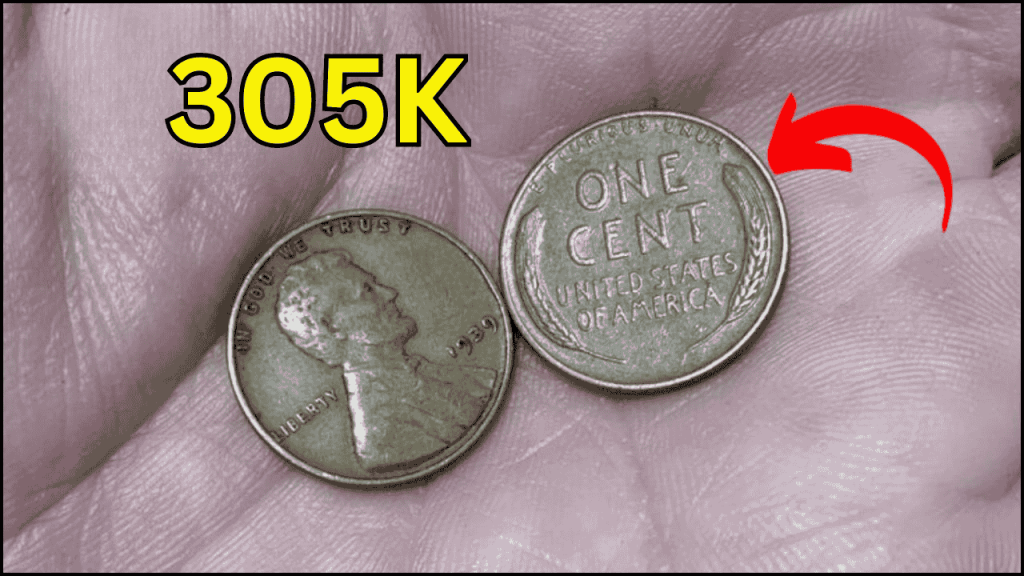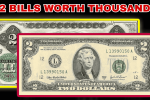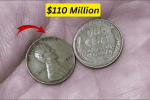
In a world where digital transactions increasingly dominate our financial landscape, it’s easy to dismiss physical currency—especially coins—as mere relics of a bygone era. Pennies, in particular, often find themselves relegated to tip jars, forgotten in coat pockets, or accumulating dust in desk drawers. Yet beneath this mundane appearance lies an extraordinary possibility: some of these humble one-cent pieces could be worth a fortune. The most striking example: a Lincoln Wheat Penny that recently sold for an astonishing $305,000—more than many homes or luxury vehicles. Even more remarkably, this valuable coin was discovered in circulation, meaning similar treasures could still be passing through our hands today.
The Birth of an American Icon
The Lincoln Wheat Penny holds a special place in American numismatic history. Introduced in 1909 to commemorate the 100th anniversary of Abraham Lincoln’s birth, it represented a significant departure from tradition. Prior to this coin, U.S. currency had never featured the portrait of an actual historical figure, instead showcasing symbolic representations like Lady Liberty or eagles.
Designed by sculptor Victor David Brenner, the coin features Lincoln’s profile on the obverse (front) side. The reverse displays two wheat stalks framing the words “ONE CENT” and “UNITED STATES OF AMERICA,” earning it the colloquial name “Wheat Penny.” This iconic design remained in production until 1958, when the wheat stalks were replaced with an image of the Lincoln Memorial.
During its nearly 50-year production run, the U.S. Mint produced billions of these pennies, making them a ubiquitous part of American commerce and culture. Yet among these billions, certain specimens stand out for their exceptional rarity and value.
What Makes a Penny Worth $305,000?
The transformation of a seemingly ordinary penny into a six-figure collectible stems from a combination of factors that create exceptional numismatic value. Understanding these elements helps collectors identify potentially valuable specimens.
Key Value Factors for Lincoln Wheat Pennies
| Factor | Description | Impact on Value |
|---|---|---|
| Rarity | How few examples exist | Primary driver of high valuations |
| Historical Significance | Connection to important events (like wartime) | Adds premium to already rare coins |
| Minting Errors | Production mistakes that created unique variations | Can turn common dates into valuable rarities |
| Condition | State of preservation (grade) | Exponentially increases value for rare dates |
| Provenance | Historical ownership record | Can add significant premium for famous collections |
| Certification | Professional authentication and grading | Essential for confirming high-value specimens |
The Most Valuable Lincoln Wheat Pennies
Several specific issues stand out for their exceptional value:
| Year/Type | Approximate Value Range | Reason for Value |
|---|---|---|
| 1943 Bronze | $100,000 – $1,000,000+ | Mistakenly struck on bronze planchets instead of steel during WWII |
| 1944 Steel | $75,000 – $500,000 | Struck on leftover steel planchets instead of copper |
| 1909-S VDB | $750 – $150,000 | Limited production run with designer’s initials |
| 1955 Double Die | $1,000 – $80,000 | Dramatic doubling error in the die |
| 1922 No D | $500 – $35,000 | Denver mint mark missing due to worn die |
| 1914-D | $250 – $12,000 | Low mintage and high demand from collectors |
| 1931-S | $100 – $6,000 | Low mintage during Great Depression |
Values vary dramatically based on condition, with uncirculated specimens commanding the highest prices.
The $305,000 Penny: A Closer Look
The record-setting Lincoln Wheat Penny that sold for $305,000 was a 1943 bronze cent. What makes this coin particularly valuable is its connection to World War II and a fascinating mint error.
During 1943, copper was needed for the war effort, so the U.S. Mint switched to producing zinc-coated steel pennies. However, a few copper planchets (blank coin discs) from 1942 remained in the presses and were accidentally struck with the 1943 dies. The result was a small number of copper pennies in a year when virtually all pennies were supposed to be steel.
Experts estimate that only about 20 genuine 1943 bronze cents exist across all three mints (Philadelphia, Denver, and San Francisco). This extreme rarity, combined with the fascinating wartime backstory, creates the perfect formula for exceptional value. What’s most remarkable is that some of these valuable pennies entered circulation, meaning they were used as everyday currency before their significance was recognized.
How to Identify Potentially Valuable Wheat Pennies
For the average person hoping to discover a valuable wheat penny in their possession, knowing what to look for is essential. The good news is that identifying key dates and features doesn’t require professional expertise—just careful observation.
Essential Examination Steps
| Step | What to Look For | Tools Needed |
|---|---|---|
| Check the Year | Focus on key dates: 1909, 1914, 1922, 1924, 1931, 1943, 1944, 1955 | Good lighting |
| Look for Mint Marks | S (San Francisco), D (Denver) below the date | Magnifying glass |
| Examine for Errors | Doubled images, off-center strikes, wrong metals | Magnifying glass |
| Assess Condition | Less wear equals higher value; look for original luster | Magnifying glass |
| Check Color | For older pennies, color indicates preservation: red (best), red-brown, brown | Good lighting |
| Verify Authenticity | Compare weight, diameter, and details with known genuine examples | Digital scale, calipers |
The Most Common Valuable Wheat Pennies by Visual Identification
| Type | Visual Identifiers | Approximate Odds of Finding |
|---|---|---|
| 1909-S VDB | “S” under date, “VDB” very small on reverse bottom | 1 in 500,000 wheat pennies |
| 1955 Double Die | Visible doubling of date and “LIBERTY” | 1 in 250,000 wheat pennies |
| 1922 Plain (No D) | No mint mark, weak detail on obverse | 1 in 100,000 wheat pennies |
| 1943 Copper | Copper color (not silver/steel), regular weight | 1 in millions |
| 1944 Steel | Silver color, magnetic, lighter weight | 1 in millions |
| 1914-D | “D” mint mark, date often worn | 1 in 50,000 wheat pennies |
| 1931-S | “S” mint mark, often better preserved | 1 in 30,000 wheat pennies |
Beyond the Hunt: The Cultural Significance of Wheat Pennies
The Lincoln Wheat Penny transcends mere monetary value; it represents a tangible connection to American history. These coins passed through millions of hands during pivotal moments of the 20th century—the Great Depression, two World Wars, the Civil Rights Movement, and the dawn of the Space Age.
Wheat pennies served as everyday currency during an era when a penny had genuine purchasing power. In the 1920s and 1930s, a single cent could buy a newspaper, postcards, or small candies. During World War II, these coins reflected America’s material sacrifices, with their composition changing to conserve essential metals for the war effort.
For many collectors, the historical context adds a dimension of value beyond the coin’s rarity or condition. Each wheat penny represents a small artifact of everyday American life, carrying with it stories of commerce, savings, and daily transactions across generations.
Starting Your Own Search
The possibility of finding a valuable wheat penny in circulation remains real, albeit challenging. While most wheat pennies disappeared from everyday use decades ago, they still occasionally surface in old collections, forgotten coin jars, and estate sales.
Where to Look for Wheat Pennies Today
| Source | Likelihood | Tips |
|---|---|---|
| Inherited Collections | High | Check family coin collections, old piggy banks, jars of saved coins |
| Bank Rolls | Medium | Purchase penny rolls from banks; some collectors still find wheat pennies |
| Estate Sales/Auctions | Medium-High | Look for old coin collections or unsorted jars of coins |
| Coin Shops’ “Junk Boxes” | Medium | Some shops sell unsorted or common wheat pennies by the pound |
| Metal Detecting | Low-Medium | Historical sites may yield wheat pennies underground |
| Everyday Change | Very Low | While rare, wheat pennies occasionally still appear in circulation |
If you believe you’ve found a valuable specimen, resist the urge to clean it—doing so can dramatically reduce its value. Instead, handle it by the edges, place it in a protective holder, and consider having it professionally authenticated and graded by a service like PCGS (Professional Coin Grading Service) or NGC (Numismatic Guaranty Corporation).
The Investment Perspective
While the discovery of a $305,000 penny makes headlines, it’s important to maintain realistic expectations about wheat penny collecting. The vast majority of wheat cents are worth only a few cents each—slightly above their face value. However, even common wheat pennies have steadily appreciated over the decades, making them a modest store of value.
The real investment potential comes from identifying key dates, mint marks, and errors that elevate certain specimens to the realm of serious numismatic collectibles. For those with knowledge and patience, assembling a curated collection of quality wheat pennies can represent both a rewarding hobby and a potential long-term investment.
Conclusion: The Enduring Allure of the Humble Penny
The story of the $305,000 Lincoln Wheat Penny reminds us that extraordinary value can be hidden in the most ordinary objects. It represents the perfect confluence of history, rarity, and human interest—a tiny metal disc that transcended its humble origins to become a numismatic treasure.
Whether you’re a serious collector or simply someone intrigued by the possibility of finding hidden wealth in your spare change, wheat pennies offer an accessible entry point into the world of coin collecting. The hunt itself—methodically examining dates, mint marks, and subtle variations—provides its own satisfaction, regardless of monetary outcomes.
So before dismissing that jar of pennies or the loose change in your pocket, take a moment to look more closely. History might be hiding in plain sight, and that overlooked one-cent piece could conceivably be worth a small fortune. In a world increasingly dominated by digital currencies and cashless transactions, the Lincoln Wheat Penny stands as a tangible reminder that value sometimes comes in unexpected forms—even as small as a penny.


